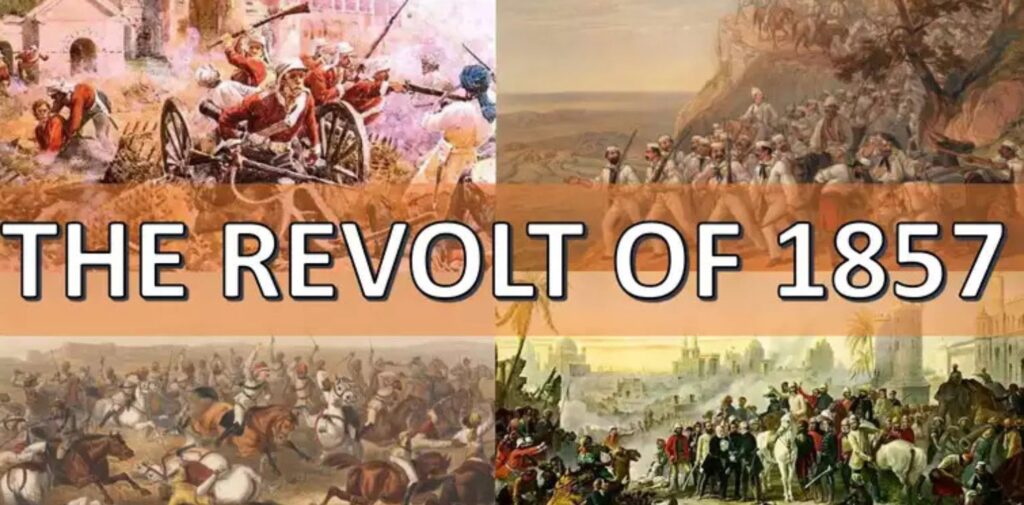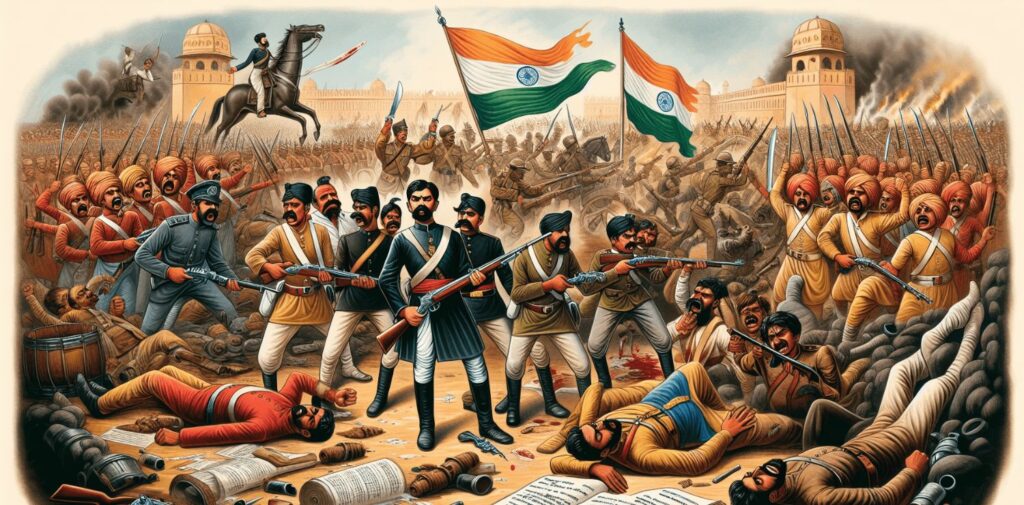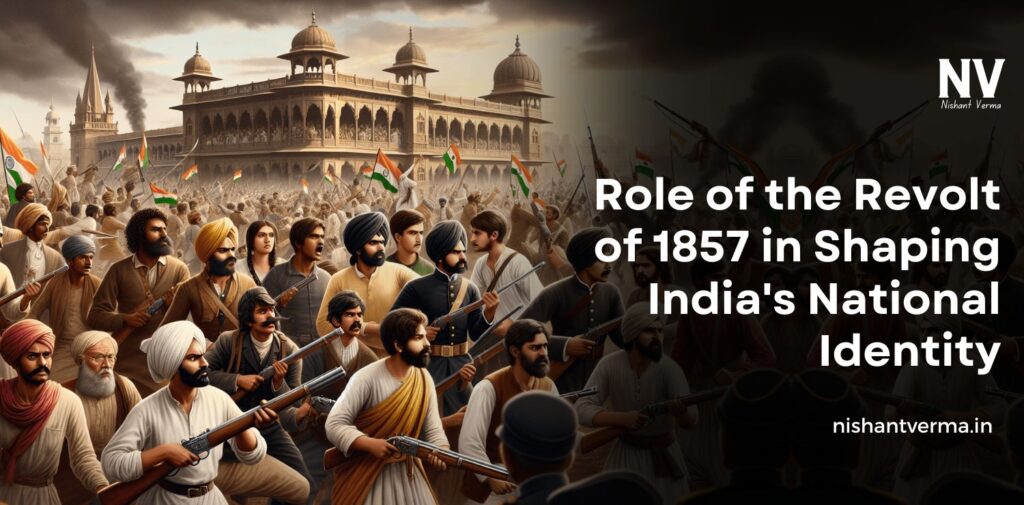The Revolt of 1857, also known as the First War of Indian Independence, was a significant chapter in the history of India’s struggle against British colonial rule. While it was not successful in its immediate goal of overthrowing British rule, the revolt played a crucial role in shaping the national identity of India and laying the foundation for future independence movements. This article will explore how the Revolt of 1857 contributed to the emergence of Indian nationalism and the formation of a collective Indian identity.
What Was the Revolt of 1857?
The Revolt of 1857 was a large-scale rebellion against British rule, sparked by several factors, including the British East India Company’s policies, religious interference, economic hardships, and the use of a new rifle cartridge that was believed to be greased with animal fat (offensive to both Hindu and Muslim soldiers). The rebellion started in Meerut on May 10, 1857, and quickly spread across northern and central India, with leaders like Mangal Pandey, Rani Lakshmibai, and Bahadur Shah Zafar emerging as symbols of resistance.
Though the revolt was suppressed after a year of intense fighting, it marked the beginning of a unified struggle for Indian independence that would continue in the years to come.

The Revolt as a Unifying Force
Before the Revolt of 1857, India was made up of various kingdoms and princely states with different cultures, languages, and religions. There was no clear sense of a unified national identity. The British had divided India into separate regions, playing on the existing divisions to maintain control. However, the revolt brought together people from all walks of life, regardless of their caste, religion, or region, to fight against a common enemy: British colonial rule.
1. A Collective Sense of Resistance
The revolt unified Hindus and Muslims, who had been divided by the British through policies like “divide and rule.” Leaders from both communities fought side by side in the revolt, and the rebellion showed that the struggle for independence was not limited to any single group. The idea of a unified India, with people standing together against foreign domination, began to take shape during the revolt.
For example, Rani Lakshmibai of Jhansi and Begum Hazrat Mahal of Lucknow, both powerful women of their time, played significant roles in leading their respective regions against the British. Their courage and leadership became symbols of resistance, inspiring people across the country to fight for their freedom, regardless of their social status or gender.
2. The Role of Indian Princes and Soldiers
The revolt also saw the involvement of many Indian rulers and soldiers. While some rulers initially remained loyal to the British, many others, like the Nawab of Oudh (now Lucknow) and the Maratha chiefs, joined the fight. The soldiers, many of whom were part of the British East India Company’s army, revolted against their foreign rulers. The fact that such a diverse range of people—princes, soldiers, farmers, and common citizens—joined forces in the revolt contributed to the idea that all Indians, irrespective of their position, could unite for a common cause.
3. The Appeal to Indian Culture and Identity
The British had often criticized and undermined Indian culture, traditions, and religious practices, which angered the native population. The revolt was seen as a defense of Indian values, traditions, and ways of life against foreign imposition. The leaders of the revolt called upon the people to protect their culture and religion from British interference, further strengthening the idea of a shared national identity.
The presence of leaders from diverse regions, including the North and South, and from various religious backgrounds, helped create a sense of belonging to one nation. This was significant because it fostered the idea that India, despite its differences, could stand united.

The Role of the Revolt in Nationalist Thought
Although the revolt was not successful in overthrowing British rule, it had a long-lasting impact on nationalist thought in India. The rebellion led to the birth of the idea that India could stand as a united nation, which was later taken up by Indian leaders during the freedom struggle in the late 19th and early 20th centuries.
1. The Beginning of Organized Nationalism
After the revolt, the British made significant changes to their policies in India, partly as a response to the uprising. They abolished the British East India Company and took direct control of India under the British Crown. This marked the beginning of British colonial rule in its most formalized sense.
At the same time, the British policies that followed the revolt, including economic exploitation and political suppression, laid the foundation for the rise of organized Indian nationalism. Indian intellectuals, like Dadabhai Naoroji, Surendranath Banerjee, and others, began to raise questions about the fairness and impact of British rule. They began to demand greater political representation and economic benefits for Indians. The revolt, in a sense, marked the beginning of this intellectual resistance to colonialism.
2. The Formation of a National Identity
Though the revolt did not succeed militarily, it helped create a sense of national consciousness that would later be pivotal in the Indian independence movement. The idea of India as a unified nation-state began to emerge, based on shared cultural, religious, and historical experiences. The leaders of the revolt, even though they were from different regions and backgrounds, were seen as symbols of a unified India, fighting against a common foreign oppressor.
In the years following the revolt, Indian leaders started to organize more formally. The Indian National Congress (INC) was founded in 1885, which became the main political body advocating for Indian rights and eventually for independence. The leaders of the INC were inspired by the ideals of the 1857 revolt and the idea that India could stand together as a single, sovereign nation.

The Legacy of the Revolt of 1857
The Revolt of 1857 remains an important symbol of resistance in Indian history. It was the first large-scale effort to unite India against British rule and paved the way for future struggles. It also helped to shift the focus of Indian resistance from individual regional uprisings to a more collective, national struggle for independence.
While the revolt itself was crushed, the British were now aware of the strength of Indian discontent. They also realized that ruling India required more than just economic control—it required managing the emotions, culture, and national pride of the people. The revolt, though unsuccessful in its immediate goals, served as a wake-up call for the British and marked the beginning of an era of more organized resistance.
1. Martyrs and Heroes
Many of the people who took part in the Revolt of 1857 were later recognized as national heroes. Figures like Mangal Pandey, who is often seen as the first to raise arms against British rule, became martyrs for the cause of freedom. Rani Lakshmibai of Jhansi is still celebrated as a symbol of bravery and patriotism. These martyrs played an important role in inspiring future generations of freedom fighters.
2. A Turning Point in India’s Fight for Independence
In hindsight, the Revolt of 1857 can be seen as a turning point in India’s fight for independence. It ignited the spark for future movements and set the stage for the larger national movements of the 20th century, including the non-violent civil disobedience led by Mahatma Gandhi. The lessons learned from the revolt—about the need for unity, organization, and the strength of Indian culture—shaped the strategies used by later freedom fighters.
Conclusion
The Revolt of 1857 was not just a military rebellion but a crucial moment in the shaping of India’s national identity. It united people from different regions, religions, and social classes under the banner of a shared goal: to resist British rule. While the immediate result was the failure of the rebellion, the long-term effect was the growth of a collective consciousness and a sense of national pride among Indians.
This revolt inspired future generations of leaders, thinkers, and activists, who took forward the struggle for independence, leading India to freedom in 1947. The Revolt of 1857 is remembered today not just for its failure, but for the powerful role it played in igniting the flame of Indian nationalism.




